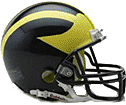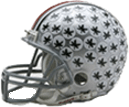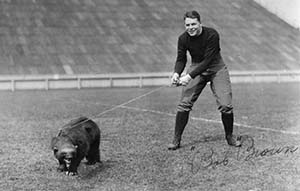Michigan does not have a live mascot comparable to Ohio's Brutus Buckeye. The Athletic Department has steadfastly maintained that such a symbol is unnecessary and undignified and would not properly reflect the spirit and values of Michigan athletics. Over the years a number of individuals and groups have proposed mascots in a variety of wolverine costumes but the department has refused to sanction them. Instead, it continues to rely on the wolverine itself as the symbol of Michigan sports.
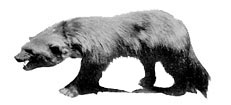
As early as 1861, the students and alumni began referring to themselves as "Wolverines." How the ferocious animal came be associated with the state and adopted as the university mascot remains a bit of a mystery, but there are several theories.
The simplest reason for the wolverine nickname would be that the animal was abundant in Michigan at some time. However, all the evidence points otherwise, as there has never been a verified trapping of a wolverine inside the state's borders, nor have the skeletal remains of a wolverine been found within the state's 96,705 square miles. The first verified sighting of a wild wolverine inside the state of Michigan ocurred in February of 2004.
The great Michigan football coach Fielding H. Yost had a theory for the nickname, which he wrote about in the Michigan Quarterly Review in 1944. Yost felt that the reason for the nickname concerned the trading of wolverine pelts which occurred at Sault Ste. Marie for many years. The trading station served as an exchange between the Native Ameericans and other trappers and fur traders, who would eventually ship the products off to Montreal or the Eastern United States. Because many of the furs were in fact wolverine pelts, the traders may have referred to them as "Michigan wolverines," leading to the state nickname and ultimately to the University of Michigan symbol.
Eight years later, in the Michigan Quarterly Review of 1952, Albert H. Marckwardt presented another theory for the "wolverine" name. Marckwardt's reasoning is based on the fact that Michigan was first settled by the French in the late 1700s. The appetites of the French were judged to be gluttonous or "wolverine-like" and, therefore, the nickname wolverines was conferred upon them.
The last theory derives from the border dispute between Michigan and Ohio in 1803, often referred to as the "Toledo War." While the two sides argued over the proper setting of the state line, Michiganders were called wolverines. It is unclear, however, whether the Michigan natives pinned this name upon themselves to show their tenacity and strength, or whether Ohioans chose the name in reference to the gluttonous, aggressive, habits of the wolverine. From then on, Michigan was labeled the "Wolverine state" and when the University of Michigan was founded, it simply adopted the nickname of the state it represented.
Fielding Yost set out to find a wolverine in 1923, after seeing Wisconsin carry live badgers along with its football team. Yost's desire met with difficulty, as the coach had problems finding a dealer of live wolverines. After a letter to 68 trappers yielded no mascot for his team, Yost expanded his wish to any wolverine, alive or dead.
Yost was finally able to obtain a mounted wolverine from the Hudson's Bay Fur Company in the fall of 1924. Captain Bob Brown posed with taxdermied wolverine on Ferry Field in 1925, improbably holding the ferocious critter on a leash.
Yost's quest for a live wolverine would continue.
In 1927, 10 wolverines were obtained from Alaska and placed in the Detroit Zoo. On big football days, two of these wolverines were brought into Michigan Stadium and carried around in cages.
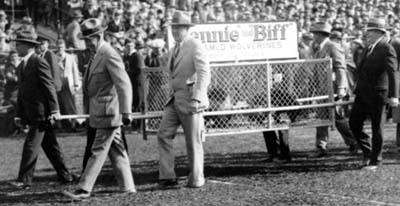
Bennie and Biff on display at the dedication of Michigan Stadium, 1927
However, the animals grew larger and more ferocious, and as Yost stated, "It was obvious that the Michigan mascots had designs on the Michigan men toting them, and those designs were by no means friendly." Therefore, the practice of bringing wolverines into the stadium had to be discontinued after only one year. However, one of the wolverines was not returned to the Detroit Zoo. Instead, "Biff" was put in a cage at the University of Michigan Zoo where students were able to visit him at all times. It is not known how long Biff survived or remained at the campus zoo, but by the the late 1930s Yost was in search of a new wolverine mascot.
In 1939, the Chevrolet Motor Company donated a wolverine (as well as the cage to keep it in) to the University of Michigan. The as yet unnamed mascot arrived on campus in time for the season opener against Michigan State. It was apparently his one and only appearance in Michigan Stadium. The Michigan Daily later reported the campus zoo agreed to house the new mascot on the condition he not be taken out to any more football games. "The excitement, musuem officials thought, would be too much for the animal."
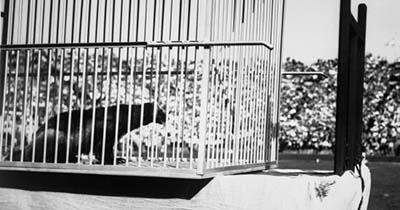
Intrepidus at Michigan Stadium, 1939
Chevrolet sponspred a contest to name the new mascot, with a new car for the winning entry and portable radios for ten runners-up. Some 7,00 entries were submitted along with a 20-word or less rationale for the prosed name. A committee made up of Prof William Burt, instructor in zoology and curator of mammals at the Museum of Zoology; fresham football coach Wally Weber, football manager Carl Wheeler; Fielding Yost, Athletic Director; and Ben Fineberg, sports editor of the Daily -- would select a winner based on "originality, unnusualness, and aptness."
Intrepidus won LSA junior Donald Rivette a new Chevorlet.
Rivette told the Daily reporter he had scanned the dictionary for inspiration and intrepid (fearless, undaunted, unshaken) caught his eye. The Latin form, he thought, "embodied the ferocity, the fighting spirit of the animal and Michigan's athletic teams."
Intrepidus ("Treppy" as he was affectionately known--if one can be affectionate towards a wolverine) surived at the campus zoo until 1948. Three years later the Daily reported the Zoology Museum was trying to find a new wolverine.
